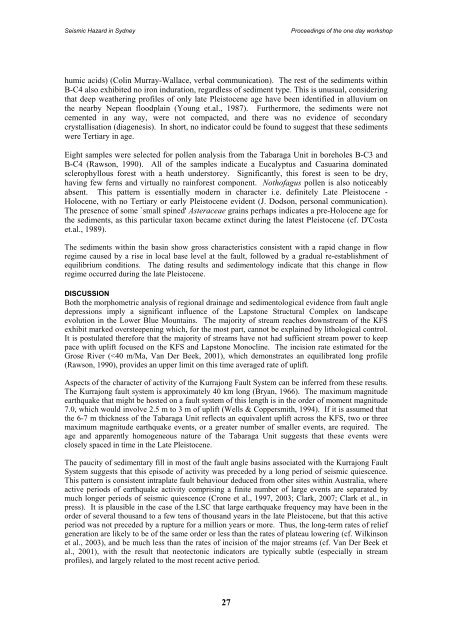Seismic Hazard <strong>in</strong> <strong>Sydney</strong>Proceed<strong>in</strong>gs of <strong>the</strong> one day workshophumic acids) (Col<strong>in</strong> Murray-Wallace, verbal communication). The rest of <strong>the</strong> sediments with<strong>in</strong>B-C4 also exhibited no iron <strong>in</strong>duration, regardless of sediment type. This is unusual, consider<strong>in</strong>gthat deep wea<strong>the</strong>r<strong>in</strong>g profiles of only late Pleistocene age have been identified <strong>in</strong> alluvium on<strong>the</strong> nearby Nepean floodpla<strong>in</strong> (Young et.al., 1987). Fur<strong>the</strong>rmore, <strong>the</strong> sediments were notcemented <strong>in</strong> any way, were not compacted, and <strong>the</strong>re was no evidence of secondarycrystallisation (diagenesis). In short, no <strong>in</strong>dicator could be found to suggest that <strong>the</strong>se sedimentswere Tertiary <strong>in</strong> age.Eight samples were selected for pollen analysis from <strong>the</strong> Tabaraga Unit <strong>in</strong> boreholes B-C3 andB-C4 (Rawson, 1990). All of <strong>the</strong> samples <strong>in</strong>dicate a Eucalyptus and Casuar<strong>in</strong>a dom<strong>in</strong>atedsclerophyllous forest with a heath understorey. Significantly, this forest is seen to be dry,hav<strong>in</strong>g few ferns and virtually no ra<strong>in</strong>forest component. Nothofagus pollen is also noticeablyabsent. This pattern is essentially modern <strong>in</strong> character i.e. def<strong>in</strong>itely Late Pleistocene -Holocene, with no Tertiary or early Pleistocene evident (J. Dodson, personal communication).The presence of some `small sp<strong>in</strong>ed' Asteraceae gra<strong>in</strong>s perhaps <strong>in</strong>dicates a pre-Holocene age for<strong>the</strong> sediments, as this particular taxon became ext<strong>in</strong>ct dur<strong>in</strong>g <strong>the</strong> latest Pleistocene (cf. D'Costaet.al., 1989).The sediments with<strong>in</strong> <strong>the</strong> bas<strong>in</strong> show gross characteristics consistent with a rapid change <strong>in</strong> flowregime caused by a rise <strong>in</strong> local base level at <strong>the</strong> fault, followed by a gradual re-establishment ofequilibrium conditions. The dat<strong>in</strong>g results and sedimentology <strong>in</strong>dicate that this change <strong>in</strong> flowregime occurred dur<strong>in</strong>g <strong>the</strong> late Pleistocene.DISCUSSIONBoth <strong>the</strong> morphometric analysis of regional dra<strong>in</strong>age and sedimentological evidence from fault angledepressions imply a significant <strong>in</strong>fluence of <strong>the</strong> Lapstone Structural Complex on landscapeevolution <strong>in</strong> <strong>the</strong> Lower Blue Mounta<strong>in</strong>s. The majority of stream reaches downstream of <strong>the</strong> KFSexhibit marked oversteepen<strong>in</strong>g which, for <strong>the</strong> most part, cannot be expla<strong>in</strong>ed by lithological control.It is postulated <strong>the</strong>refore that <strong>the</strong> majority of streams have not had sufficient stream power to keeppace with uplift focused on <strong>the</strong> KFS and Lapstone Monocl<strong>in</strong>e. The <strong>in</strong>cision rate estimated for <strong>the</strong>Grose River (
Seismic Hazard <strong>in</strong> <strong>Sydney</strong>Proceed<strong>in</strong>gs of <strong>the</strong> one day workshopThere is an apparent conflict between this evidence for recent activity and <strong>the</strong> palaeomagnetic data<strong>in</strong>dicat<strong>in</strong>g that fold<strong>in</strong>g related to <strong>the</strong> Lapstone Monocl<strong>in</strong>e occurred prior to 8 ± 5 Ma (Bishop et.al.,1982 with ages recalculated by Pillans, 2003). Given that <strong>the</strong> Kurrajong Fault System and <strong>the</strong>Lapstone Monocl<strong>in</strong>e form part of <strong>the</strong> same structure (Herbert, 1989; Fergusson, this volume),deformation on <strong>the</strong> one might be expected to be accompanied by deformation on <strong>the</strong> o<strong>the</strong>r. Onepossibility, which is testable by careful field observation, is that <strong>the</strong> bl<strong>in</strong>d fault underly<strong>in</strong>g <strong>the</strong>Lapstone Monocl<strong>in</strong>e (see Gibson, this volume) reached <strong>the</strong> surface <strong>in</strong> <strong>the</strong> Pliocene and deformations<strong>in</strong>ce <strong>the</strong>n has been accrued by slid<strong>in</strong>g along <strong>the</strong> fault ra<strong>the</strong>r than by fold<strong>in</strong>g. Alternatively, <strong>the</strong>recent active period may have been <strong>the</strong> first s<strong>in</strong>ce <strong>the</strong> late Tertiary (cf. Branagan & Pedram, 1990) orMesozoic (cf. Pickett & Bishop, 1992; Schmidt et al., 1992).Given <strong>the</strong> very low uplift rates postulated for <strong>the</strong> LSC, passive exhumation (cf. Pickett and Bishop1992) is likely to have played a significant role <strong>in</strong> <strong>the</strong> development of <strong>the</strong> contemporary landscape.In particular, <strong>the</strong> fact that <strong>the</strong> Tertiary Rickabys Creek Gravels overly Wianamatta Group shales on<strong>the</strong> Cumberland Pla<strong>in</strong>, and Hawkesbury Sandstone on <strong>the</strong> face and top of <strong>the</strong> Lapstone Monocl<strong>in</strong>e,implies that erosional lower<strong>in</strong>g of <strong>the</strong> landsurface had stripped shale from many areas west of <strong>the</strong>syn-depositional warp (proto-Lapstone Monocl<strong>in</strong>e) by <strong>the</strong> time of gravel deposition, but not to <strong>the</strong>extent that significant relief was generated [as <strong>in</strong>dicated by structure with<strong>in</strong> <strong>the</strong> gravels suggest<strong>in</strong>g abraided stream depositional environment, Bishop & Hunter (1990)]. However, we demonstrate asignificant tectonic impr<strong>in</strong>t <strong>in</strong> <strong>the</strong> geomorphology of streams cross<strong>in</strong>g <strong>the</strong> LSC, as dist<strong>in</strong>ct from <strong>the</strong>lithologic control that would be expected to dom<strong>in</strong>ate <strong>in</strong> a scenario only <strong>in</strong>volv<strong>in</strong>g passiveexhumation. Additional research, guided by new erosion rate data obta<strong>in</strong>ed on streams withcatchment areas significantly smaller than <strong>the</strong> Grose River, is required to determ<strong>in</strong>e def<strong>in</strong>itivelywhe<strong>the</strong>r this tectonic impr<strong>in</strong>t relates only to <strong>the</strong> last active period identified <strong>in</strong> <strong>the</strong> sediments ofBurralow Swamp, or to periodic activity throughout <strong>the</strong> late Tertiary.Intuitively, <strong>the</strong> prom<strong>in</strong>ent ‘V-notch’ valley profiles of streams between <strong>the</strong> Kurrajong Fault Systemand <strong>the</strong> Lapstone Monocl<strong>in</strong>e suggest a recent tectonic history extend<strong>in</strong>g beyond <strong>the</strong> last activeperiod. Fur<strong>the</strong>rmore, it is tempt<strong>in</strong>g to speculate that <strong>the</strong> apparent associations between <strong>the</strong> LSC andMiocene volcanics (Pedram, 1983; Branagan and Pedram, 1990; Van Der Beek et al., 2001) relate tolate Tertiary development of <strong>the</strong> complex, synchronous with <strong>the</strong> establishment of <strong>the</strong> current crustalstress field, and a pulse of tectonic activity recorded <strong>in</strong> all sou<strong>the</strong>ast <strong>Australia</strong>n bas<strong>in</strong>s (Dick<strong>in</strong>son etal., 2002; Sandiford et al., 2004). A terrestrial analogue to this pulse of deformation is seen <strong>in</strong> <strong>the</strong>Lake George Fault, which has accumulated up to 200 m of throw s<strong>in</strong>ce <strong>the</strong> late Miocene (Abel,1985).CONCLUSIONSThe results of morphometric analysis of dra<strong>in</strong>age l<strong>in</strong>es cross<strong>in</strong>g <strong>the</strong> nor<strong>the</strong>rn Lapstone StructuralComplex show <strong>in</strong>dicators of geologically recent, and potentially ongo<strong>in</strong>g tectonic deformation.Stream long-profiles oversteepen as <strong>the</strong>y cross major faults, valley cross sections narrow to ‘Vnotches’where streams enter <strong>the</strong> upthrown side of fault blocks, and several streams have beenpartially dammed, form<strong>in</strong>g swamps and lakes. While <strong>the</strong>se <strong>in</strong>dicators are consistent with a model ofperiodic (perhaps temporally clustered) deformation of <strong>the</strong> Kurrajong Fault System, near to <strong>the</strong>threshold conditions of uplift/<strong>in</strong>cision, additional erosion rate data is required to determ<strong>in</strong>e <strong>the</strong>relative contribution of passive exhumation of syn-depositional bas<strong>in</strong> structure <strong>in</strong> form<strong>in</strong>g <strong>the</strong>present landscape.The important question to ask relat<strong>in</strong>g to seismic hazard is whe<strong>the</strong>r faults of <strong>the</strong> LSC are still with<strong>in</strong>an active period, or whe<strong>the</strong>r we are now <strong>in</strong> a quiescent period that might last many hundreds ofthousands to a million years or more (cf. Crone et al., 2003). Earthquake epicenters located at depthto <strong>the</strong> west of <strong>the</strong> LSC (Gibson, this volume) potentially <strong>in</strong>dicate that <strong>the</strong> most recent active periodhas not yet f<strong>in</strong>ished.28
















